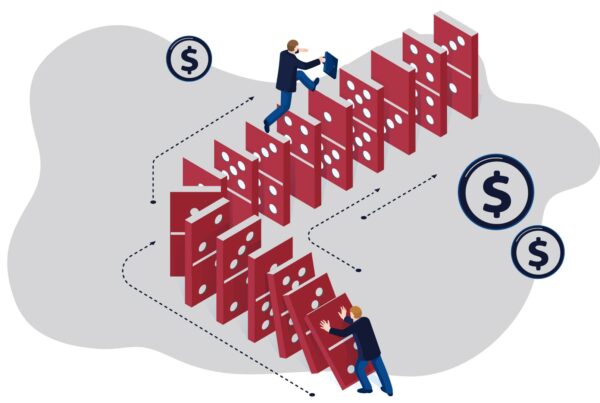Key Takeaways:
- Confidence in projections drives confidence in execution.
- Leaders can use psychological strategies to build belief in the numbers.
- When teams own their projections, they own the outcomes, and success follows.
The Gap Between Knowing and Believing
“The path to guaranteed outcomes is not just about predicting MROI; it’s about inspiring teams to confidently stand behind their projections. Inspiration, paired with knowledge, is the true catalyst for guaranteed success.”
— The B2B Marketing Revolution®
Battle 12, the final chapter of the 12 Battles™ Framework, tackles the hardest and most human element of predictable marketing success: belief.
You can have airtight research, perfectly modeled MROI projections, and a bulletproof strategy. Yet, if your team doubts the math or their ability to hit the numbers, your revolution stalls.
That disconnect between intellectual agreement and emotional conviction is the confidence gap.
It’s not about analytics. It’s about psychology.
Why Belief in the Math Matters
The B2B Marketing Revolution® calls confidence the final multiplier of marketing ROI. It’s what turns insight into execution.
When teams believe in the math, they:
- Move faster because they trust the direction.
- Push harder because they see results as possible, not theoretical.
- Stay resilient when challenges hit because faith in the model sustains them.
Belief drives behavior. Doubt drives delay.
You can’t build a predictable growth engine on hesitation.
The Science Behind Confidence
Research in organizational psychology shows that confidence isn’t just emotional; it’s causal. Studies from Harvard Business Review and the American Psychological Association consistently demonstrate that teams with high collective efficacy(shared belief in their ability to reach goals) outperform low-confidence teams even when skills are identical.
Confidence creates what psychologists call the expectancy effect: when people expect success, they behave in ways that make success more likely.
I recognized this dynamic while leading RedRover through hundreds of client transformations. The teams that won weren’t necessarily the most experienced; they were the ones who believed their math was achievable and therefore fought to make it real.
Battle 12 exists to help CEOs cultivate that same conviction.
Eight Psychological Strategies to Build Confidence
“Following are eight psychological strategies a CEO or marketing leader can employ to instill confidence in their team regarding their MROI projections.”
-The B2B Marketing Revolution®
These eight strategies, grounded in both behavioral research and field-tested leadership, bridge the gap between intellectual understanding and emotional belief.
1.Make the Math Visible
Post MROI (marketing return on investment) projections, CAC (customer acquisition cost) targets, and conversion goals where everyone can see them. Integrate them into weekly meetings and dashboards.
Transparency transforms the math from a mysterious executive exercise into a shared mission.
When numbers become part of the culture, they stop feeling like judgment and start feeling like a scoreboard.
2.Normalize Talking About the Numbers
Silence around metrics signals discomfort.
Encourage open dialogue about performance, projections, and what’s working. Ask questions in public: “What do we think is driving this variance?”When the conversation is constant, fear fades. Talking about numbers turns them from threats into tools.
Confidence grows through repetition.
3. Tie Every Role to the Result
People believe in what they influence.
Map every role to the MROI equation. Show the social strategist how engagement feeds the top of the funnel, the content writer how message clarity impacts CAC, the account manager how retention drives LTV (customer lifetime value).When employees can connect their daily work to revenue outcomes, belief becomes personal.
4.Reframe Failure as Data
Battle 12 teaches that variance is feedback, not failure.
If your forecast misses the mark, treat it as insight. Ask: “What did this teach us about our assumptions?” Every iteration improves accuracy.
When your team learns that every result, good or bad, moves you closer to predictability, they stop fearing the numbers and start trusting them.
5. Create Wins Early and Often
Break your annual goals into smaller milestones and celebrate them visibly.
Each early win confirms the math and builds the belief that “we can do this.” Confidence isn’t built in a boardroom; it’s built in moments of proof.
6. Teach the Why Behind the Numbers
Teach your team how projections are built: what data informs them, what assumptions drive them, and what levers can change them.
When people understand why the numbers make sense, they stop viewing them as arbitrary mandates. They see them as logical extensions of strategy.
Knowledge fuels belief.
7.Model Confidence as a Leader
Your team takes emotional cues from you. If you hedge your projections with doubt, they’ll adopt that same uncertainty.
Speak with conviction. Show the data. Demonstrate your trust in the model.
Leadership confidence becomes the emotional anchor of the entire plan.
8.Connect the Math to the Mission
Remind your team why the math matters: hitting projections funds jobs, fuels innovation, stabilizes the company, and impacts communities.
When people see how performance fuels purpose, they move from compliance to commitment.
This is the psychological tipping point where belief becomes culture.
From Numbers to Ownership
When confidence is collective, ownership follows.
Teams that once said, “That’s leadership’s forecast,” begin saying, “Those are our numbers.”
That subtle language shift transforms accountability:
- From blame to responsibility.
- From fear to pride.
- From pressure to purpose.
Battle 12 calls this belief transfer—when leadership’s conviction transfers to the team until it becomes self-sustaining.
Once that happens, results accelerate because no one’s waiting for permission to perform.
Case in Point: Turning Belief into Breakthrough
One RedRover client, a mid-market technology company, spent years hitting only 70% of their marketing targets. Their math was sound; their confidence wasn’t.
After implementing the eight strategies, they shifted tone entirely.
Leadership began every meeting by revisiting projections. Small victories were celebrated publicly. Misses were analyzed without blame.
Six months later, their team not only hit projections; they exceeded them by 15%.
The math didn’t change. The mindset did.
How Belief Strengthens Predictability
Predictability doesn’t come from perfect models. It comes from teams who execute those models with conviction.
When your team believes:
- Projections become self-fulfilling.
- Data becomes more accurate because execution is consistent.
- Energy focuses on optimization, not justification.
Confidence amplifies competence. It’s the invisible multiplier that turns analysis into action.
Closing the Confidence Gap in Your Organization
To inspire belief, start with an honest audit.
- Gauge trust in the numbers. Ask your team privately: “Do you believe these projections are achievable?” Their answers reveal the size of your gap.
- Clarify assumptions. Doubt thrives in confusion. Explain where the data comes from.
- Apply the eight strategies. Visibility, dialogue, and early wins change culture faster than any speech.
- Reinforce belief consistently. Confidence fades if it’s not nurtured. Keep it visible and celebrated.
Confidence isn’t a moment. It’s a muscle. Build it through repetition, feedback, and celebration.
Start a Revolution: Lead with Belief
Battle 12 of The B2B Marketing Revolution® reminds leaders that data alone doesn’t guarantee outcomes. Belief does.
Because belief in the math drives belief in the mission.
When your team believes:
- Execution accelerates.
- Collaboration deepens.
- Outcomes compound.
Guaranteed marketing results are never just an equation. They’re an equation + emotion.
If you’ve built your strategy on solid research, the final step is to light it with conviction.
Inspire belief. Close the confidence gap. Start your revolution.
By Lori Turner-Wilson, RedRover CEO/Founder, Internationally Best-Selling Author of The B2B Marketing Revolution™: A Battle Plan for Guaranteed Outcomes
Taking Action
The above insights are part of hundreds of best practices found in The B2B Marketing Revolution™: A Battle Plan for Guaranteed Outcomes — the playbook that middle-market B2B CEOs and marketing leaders lean on to scale. Backed by a groundbreaking research study, this book offers time-tested best practices, indispensable KPIs for benchmarking, insights on where your dollars are best spent, and, above all, the proven 12 Battles™ Framework for generating guaranteed marketing outcomes. The B2B Marketing Revolution™ is a battle-hardened approach to becoming an outcomes-first leader who’s ready to shake up the status quo, invest in high-payoff market research and optimization, and — yes — even torch what’s not serving your endgame. Download more than 50 templates, scripts, and tools from the book on the Battle Reader Hub.
If you’d like to talk about how to build a marketing engine that delivers predictable results — whether you want to build it yourself or tag in our team to lead the way — we’d be delighted to help you get started.







